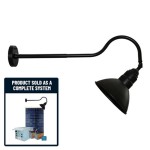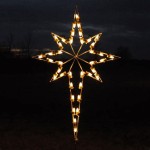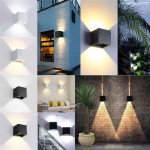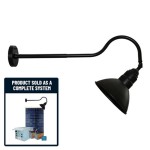Illuminating Your Outdoor Oasis: A Guide to Garden Lighting Ideas
Outdoor garden lighting serves a multifaceted purpose, extending beyond mere illumination. It enhances the aesthetic appeal of landscapes, highlighting architectural features, and creating a welcoming ambiance for evening enjoyment. Strategically placed lighting also contributes to safety and security, deterring potential intruders and preventing accidents by illuminating pathways and steps. The selection of appropriate lighting solutions should consider the desired effect, the architectural style of the property, and the functional needs of the outdoor space.
The vast array of available options allows for customization tailored to individual preferences and specific garden layouts. From subtle, low-voltage fixtures to dramatic spotlights and solar-powered alternatives, the possibilities for transforming an ordinary garden into an enchanting outdoor living area are virtually limitless. This article will explore various garden lighting ideas, providing insights into their applications and benefits, assisting in the creation of a visually appealing and functional outdoor environment.
Defining Your Garden Lighting Goals
Before embarking on a garden lighting project, it is crucial to establish clear objectives. Determining the primary purpose of the lighting will significantly influence the selection and placement of fixtures. Is the goal to enhance the aesthetic appeal of the garden, to provide security, or to create a comfortable space for outdoor entertaining? A clear understanding of these objectives will guide the design process and ensure that the final result aligns with the intended use.
Consider the specific areas of the garden that require illumination. Pathways, patios, decks, and focal points such as trees, shrubs, and water features, each require different lighting approaches. Pathways benefit from low-level lighting to guide foot traffic and prevent accidents. Patios and decks may require brighter, more ambient lighting for dining and socializing. Focal points can be accentuated with spotlights or uplighting to draw attention and create visual interest.
Furthermore, define the desired mood and ambiance. Warm lighting creates a cozy and inviting atmosphere, while cool lighting can provide a more modern and sophisticated feel. Color temperature, measured in Kelvin (K), plays a crucial role in achieving the desired effect. Lower Kelvin values (2700K-3000K) produce warm, yellow light, while higher Kelvin values (4000K-5000K) produce cool, white light. Choosing the appropriate color temperature can significantly impact the overall ambiance of the garden.
Exploring Different Types of Garden Lighting Fixtures
The market offers a diverse range of garden lighting fixtures, each designed for specific applications and effects. Understanding the characteristics of each type is essential for making informed decisions and achieving the desired outcome. Some of the most common types of garden lighting fixtures include:
*Path Lights:
These low-level fixtures are designed to illuminate pathways and walkways, providing safety and guidance. They typically feature shielded bulbs to direct light downwards, minimizing glare and light pollution. Path lights are available in various styles, from traditional lanterns to modern, minimalist designs. *Spotlights:
Spotlights are used to highlight specific features in the garden, such as trees, shrubs, sculptures, or architectural details. They provide focused beams of light, creating dramatic effects and drawing attention to focal points. Spotlights are available in various sizes and wattages, allowing for precise control over the intensity and direction of the light. *Floodlights:
Floodlights provide broad, even illumination over a large area. They are often used for security purposes, illuminating driveways, yards, and other areas prone to intrusion. Floodlights typically have wide beams and high wattages, providing ample light coverage. *Uplights:
Uplights are placed at ground level and directed upwards, illuminating trees, walls, or other vertical surfaces. They create a dramatic effect, accentuating the height and texture of these features. Uplights can also be used to create silhouettes and shadows, adding depth and visual interest to the garden. *Downlights:
Downlights are mounted on trees or structures and directed downwards, providing ambient lighting for patios, decks, or other outdoor living areas. They create a soft, diffused light that is ideal for dining, relaxing, and socializing. Downlights can also be used to illuminate pathways from above, providing a unique and stylish alternative to traditional path lights. *String Lights:
String lights, also known as fairy lights or bistro lights, add a festive and whimsical touch to any outdoor space. They consist of a string of small bulbs, typically incandescent or LED, that can be draped over trees, shrubs, fences, or pergolas. String lights are ideal for creating a warm and inviting atmosphere for outdoor gatherings. *Solar Lights:
Solar lights are powered by the sun, making them an energy-efficient and environmentally friendly option. They typically consist of a solar panel, a battery, and an LED bulb. Solar lights are available in various styles, including path lights, spotlights, and decorative lights. However, their performance depends on sunlight availability and battery capacity.The selection of appropriate fixtures depends on the specific needs and preferences of the homeowner. It is important to consider the architectural style of the property, the desired effect, and the functional requirements of the outdoor space when choosing garden lighting fixtures.
Practical Tips for Garden Lighting Design and Installation
Proper design and installation are crucial for achieving optimal results with garden lighting. Careful planning and attention to detail can enhance the aesthetic appeal of the garden, improve safety and security, and create a comfortable and inviting outdoor living area.
*Plan the Layout:
Before installing any fixtures, create a detailed lighting plan. Sketch the garden layout and identify the areas that require illumination. Consider the placement of trees, shrubs, water features, and architectural details. Experiment with different lighting techniques, such as uplighting, downlighting, and spotlighting, to achieve the desired effect. *Choose the Right Voltage:
Garden lighting systems typically operate on either low voltage (12V) or line voltage (120V). Low-voltage systems are safer and easier to install, as they do not require buried conduit. Line-voltage systems provide more power and are suitable for larger areas or for powering multiple fixtures. Consult with a qualified electrician to determine the appropriate voltage for the specific installation. *Use Weather-Resistant Fixtures:
Outdoor lighting fixtures are exposed to the elements and must be durable enough to withstand rain, snow, and extreme temperatures. Choose fixtures that are specifically designed for outdoor use and that are made from weather-resistant materials such as stainless steel, brass, or powder-coated aluminum. *Conceal Wiring:
Conceal wiring whenever possible to maintain a neat and aesthetically pleasing appearance. Bury wires underground or run them along fences or walls. Use weatherproof connectors and junction boxes to protect wiring from moisture and corrosion. *Consider Light Pollution:
Be mindful of light pollution and avoid directing light upwards into the night sky. Use shielded fixtures that direct light downwards and avoid over-illuminating the garden. Consider using motion sensors to automatically turn off lights when they are not needed. *Focus on Layers of Light:
Create depth and visual interest by using multiple layers of light. Combine ambient lighting, task lighting, and accent lighting to create a well-balanced and inviting outdoor space. Ambient lighting provides overall illumination, task lighting provides focused light for specific activities, and accent lighting highlights focal points and adds visual interest. *Regular Maintenance:
Regular maintenance is essential for ensuring the longevity and performance of garden lighting systems. Clean fixtures regularly to remove dirt and debris. Replace burned-out bulbs promptly. Inspect wiring and connections for damage. Trim trees and shrubs that may be obstructing the light.By following these practical tips, homeowners can create a beautiful and functional garden lighting system that enhances the aesthetic appeal of their property, improves safety and security, and creates a comfortable and inviting outdoor living area.
Choosing the correct bulb is also important. LED bulbs are energy-efficient and long-lasting, making them a popular choice for garden lighting. They are available in various colors and brightness levels, allowing for customization to suit specific needs. Halogen bulbs provide a brighter, more intense light than LED bulbs, but they consume more energy and have a shorter lifespan. Incandescent bulbs are the least energy-efficient option and have the shortest lifespan. Consider the energy efficiency, lifespan, and light quality when choosing bulbs for garden lighting fixtures.
Dimmer switches can allow for control over the intensity of the light, creating different moods and atmospheres. Consider installing dimmer switches on patio lights or string lights to adjust the brightness based on the occasion. Timer devices can automatically turn lights on and off at preset times, providing convenience and energy savings. Consider using timer to automatically turn on pathway lights at dusk and turn them off at dawn.

Pin On House

50 Garden Lights Ideas And Designer Fixtures For Your Outdoor Space

10 Best Outdoor Lighting Ideas Landscape Design Secrets A Piece Of Rainbow

28 Backyard Lighting Ideas How To Hang Outdoor String Lights

19 Outdoor Garden Lighting Ideas Partylite

10 Best Outdoor Lighting Ideas Landscape Design Secrets A Piece Of Rainbow

Inspirational Outdoor Lighting Ideas 6 X Bright Garden Light Tips

50 Garden Lights Ideas And Designer Fixtures For Your Outdoor Space

Outdoor String Light Ideas Oclights

Garden Lighting Ideas That Illuminate Your Nights Jysk
Related Posts







